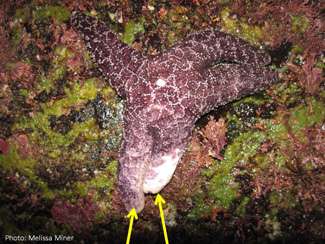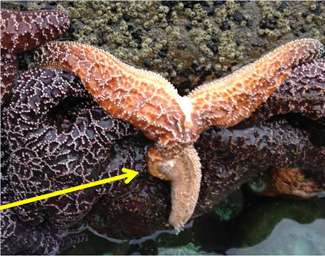Marine scientists track spread of sea star wasting disease

(Phys.org) —A mysterious disease that causes sea stars to decay and fall apart within a few days has become widespread along the U.S. west coast over the past several months. First reported off the coast of Washington in June, the disease known as "sea star wasting syndrome" has now been observed as far north as southeast Alaska and as far south as Orange County, California.
Pete Raimondi, professor and chair of ecology and evolutionary biology at UC Santa Cruz, leads the Pacific Rocky Intertidal Monitoring Program, which has been documenting the disease at the group's long-term monitoring sites along the west coast and collecting reports from other scientists and citizens. According to Raimondi, small outbreaks of the disease have been observed for decades, but this one is particularly troubling because it is so widespread.
"We've never seen it at this scale up and down the coast," he said.
The disease has even hit sea stars in public aquariums that draw water from the ocean for their tanks, including UCSC's Seymour Center at Long Marine Lab, the Vancouver Aquarium, and the Gulf of the Farallones National Marine Sanctuary visitor center.
Raimondi said citizens can help by reporting observations of the disease on his group's Sea Star Wasting Syndrome web site. The site includes detailed descriptions of the disease, photographs, maps, regular updates, and instructions for tracking and documenting observations.
The cause of the disease is still unknown. Researchers think it is caused by a bacterial or viral pathogen, and several groups are working to identify the specific pathogen. Past outbreaks have been associated with warmer than normal water temperatures, but that does not seem to be the case this time, Raimondi said.

The syndrome has been reported at several sites around Monterey Bay, including sites in Santa Cruz and Monterey. It has also been reported on the U.S. east coast. At least ten species of sea stars are known to be affected by the disease. The hardest hit species on the west coast is Pisaster ochraceus, a large, common, purple-and-orange sea star that preys on mussels.
While concern about the disease has been building in the scientific community since early summer, it has only recently begun to garner widespread media attention. Raimondi said he has done nearly a dozen interviews within the past few days, including a television interview at Long Marine Lab broadcast on NBC Bay Area.
Provided by University of California - Santa Cruz



















